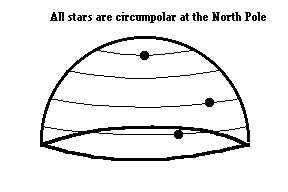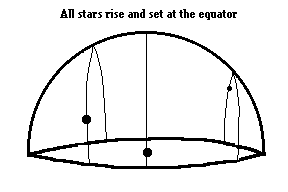
This is another great chance for you to use Stellarium. All these things are much easier to understand if you can see them happening in a virtual sky.
Even at an early age, most people are aware of specific changes observed in the sky. The most common one is:

The Earth rotates ... changing the sky on a daily cycle.
The day/night cycle - As you know, the sun rises in the east and sets in the west. This apparent motion of the sun across the sky is one example of diurnal motion (meaning daily motion). The early Greeks adopted a model where Earth remained stationary, and the sun did the moving. Children now learn in kindergarten that Earth rotates on its axis ... making the sun appear to move across the sky. For the same reason, the moon rises and sets each day. In fact, the careful observer will notice that stars rise and set for the same reason, all because Earth is spinning once every 24 hours (actually 23h 56m 04.0905s) on its axis.
I have a movie clip of the sky as seen from Milwaukee looking east (on the first day of spring). Notice that ALL objects rise ... not just the sun. The file is large .wmv format (4 MB) OR .mp4 format (2 MB).
Because Earth is rotating on its axis, the sky is always changing. During the course of one day, the entire celestial sphere appears to make one complete "orbit" around the sky. The center of this motion is the north celestial pole (which appears to be "fixed" in the sky). Polaris (also known as the North Star) just happens to lie within 1 degree of the true pole. This is close enough to say that Polaris is the only object in the sky that does not appear to move within a 24 hour period.

The sky appears to spin around Polaris in this (lame) animation.
I have a movie clip of the sky as seen from Milwaukee looking north. Notice anything different from the view looking east? The file is very large .wmv format (8 MB) OR .mp4 format (7 MB).
This leads to some interesting effects ... namely:
If an object is close to Polaris, its diurnal "orbit" may not intersect the horizon and it never rises or sets! These regions are called circumpolar regions. Some very familiar constellations are circumpolar for observers in Milwaukee ... The "Big Dipper" is circumpolar and can be seen any given night in Milwaukee.
Circumpolar region in Milwaukee

I made a movie clip that displays a fisheye view of the sky
as seen from the north pole. The file is large
.wmv format (4 MB) OR
.mp4 format (4 MB).
I also have a movie clip showing a close up view of the horizon at the north
pole. The file is large
.wmv format
(3 MB) OR .mp4 format (3 MB).

I made a movie clip that displays a "fish eye" view of the sky as seen from the equator. The file is large .wmv format (5 MB) OR .mp4 format (4 MB). I also have a movie clip showing a close up view of the horizon at the equator. The file is large .wmv format (3 MB) OR .mp4 format (3 MB).
Stellarium users have a big advantage here. Simply set yourself in Milwaukee and look north. Kill the atmosphere so you can always see the stars. Now fast forward time and watch the stars circle Polaris. You can even mark the celestial north pole and zoom in to see that Polaris is actually a tiny bit off the celestial pole. Everything actually circle the celestial north pole ... but we can ignore this tiny difference. Notice the circumpolar region as seen in Milwaukee. Now change your latitude (you can simply click on the map or enter any latitude manually) and see how the sky differs on a daily time scale if you are closer to equator or closer to Earth's north pole.
ŠJim Mihal 2004, 2014, 2019- permission to copy for
any non-profit educational purpose